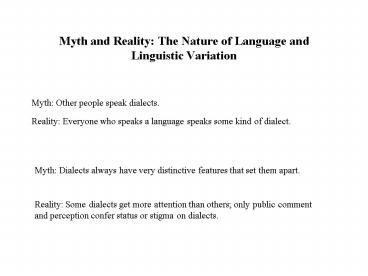Myth and Reality: The Nature of Language and Linguistic Variation - PowerPoint PPT Presentation
1 / 23
Title:
Myth and Reality: The Nature of Language and Linguistic Variation
Description:
In America now, so-called r-less speech has covert prestige in some locales (New ... How does AAE relate to other varieties of present-day English? ... – PowerPoint PPT presentation
Number of Views:168
Avg rating:3.0/5.0
Title: Myth and Reality: The Nature of Language and Linguistic Variation
1
Myth and Reality The Nature of Language and
Linguistic Variation
Myth Other people speak dialects.
Reality Everyone who speaks a language speaks
some kind of dialect.
Myth Dialects always have very distinctive
features that set them apart.
Reality Some dialects get more attention than
others only public comment and perception confer
status or stigma on dialects.
2
Myth and Reality The Nature of Language and
linguistic Variation
Myth Dialects are ungrammatical they deviate
from normal speech.
Reality Dialects are systematic and
rule-governedthey can be described with the same
precision and analysis as standard varieties.
Myth Dialects inherently carry negative social
connotations.
Reality Social connotations are derived strictly
from the social position of the speech community
that utilizes a given dialect.
3
Speech Varieties register idiolect
sociolect regional dialect
standard formal individual gender
geographical superposed informal
SE class technical
ethnicity etc.
etc.
Speech varieties interacteach type is
conditioned by all the other types.
4
Speech varieties and speech events
Overt prestigenorms associated with either the
standard or some other equally prestigious variety
In America now regionally, socially unmarked
speech
In America in the past so called r-less variety
In Britain regional dialect of
London-Cambridge-Oxford known as Received
Pronunciation (RP)
5
Speech varieties and speech events
Covert prestigenorms associated with regionally
or socially local patterns
In America now, so-called r-less speech has
covert prestige in some locales (New York,
Boston, Charleston, SC, etc.), while r-ful speech
has overt prestige generally in America.
an r-ful pronunciation New York the general
("Midwestern") prestige pattern
an r-less pronunciation New Yawk the more local
(New England) prestige pattern
6
African American English (AAE) is generally a
sociolect, but its use is conditioned by
register, idiolect, geography, and Standard
American English (SAE).
- ca. 10 of the US population is African
American, but not all speak AAE - many different varieties of AAE
- due to geographical and sociological differences
(north south, rural urban, female male,
social class, neighborhoods,professions etc.)
7
- William Labov, University of Pennsylvania, is
usually credited with initiating the scholarly
study of AAE. - 1966. The Social Stratification of English in New
York City. Washington, DC Center for Applied
Linguistics. - 1972. Language in the Inner City Studies in the
Black English Vernacular. Philadelphia
University of Pennsylvania Press.
The study of AAE is currently one of the most
vigorous areas of sociolinguistic research.
8
- Actually, Lorenzo Dow Turner (1895-1972), the
first formally trained African American linguist,
produced the first scholarly analysis of African
American speech. - 1949. Africanisms in the Gullah Dialect.
9
Changing terminology reflects the advance of
research
- Negro English
- Black English
- Black English Vernacular (BEV)
- Afro-American English
- African American Vernacular English (AAVE)
African American English is now generally
accepted.
10
History of AAE
- Languages and language varieties are born,
develop, change, and (sometimes) die over
timeHow did AAE begin? How has it changed?
What are its characteristics today?
- How does AAE relate to African languages?
- How does AAE relate to early Modern English (ca.
1500-1800)?
- How does AAE relate to other varieties of
present-day English?
11
- Most modern linguists have noticed striking
similarities between AAE and the languages known
as Hamito-Bantu, which are spoken in an area
known as Niger-Congo and includes the Ivory Coast
where much of the slave trade found port.
12
(No Transcript)
13
(No Transcript)
14
(No Transcript)
15
(No Transcript)
16
(No Transcript)
17
(No Transcript)
18
3 Hypotheses of the Origin and Development of AAE
- Anglicist (mid 20th C) AAE derived directly
from British-based dialects and modern AAE is
equivalent to rural Southern white speech
- Eurocentric
- Speakers of indigenous African languages acquired
English quickly and/or no vestiges of early
language contact remain - Features of AAE derive from other varieties of
English, primarily white Southern varieties
19
3 Hypotheses of the Origin and Development of AAE
- Creole (1960s-70s) AAE derived from creole
found in African diaspora
- developed from a pidgin
- Haitian Creole French
- Jamaican Creole English
- Gullah?
20
3 Hypotheses of the Origin and Development of AAE
- Neo-Anglicist (1990s) postcolonial African
American speech similar to early British
dialects, but AAE has diverged from European
American speech
- Differences between AAE and other varieties of
American English are creations of the twentieth
centurynot an older linguistic inheritance
21
Who is right?
Problems associated with the study of AAE
- Nature of texts
- Problems include questions of authorship,
questions about models (native speech or
literary?), manipulation of written code (does
orthographical ability obscure facts of oral
language?), representativeness (is writer a
representative speaker?) - Audio recordings made in 1930s include speakers
born in 1860s, but are rare, sparse, and of poor
quality
American Folk Life Center of the Library of
Congress
22
Problems associated with the study of AAE
- Sociohistorical context
- Demographic Sociohistorical circumstances are
very important - Issues include migration, contact ecology,
population demographics, social valuation
23
Problems associated with the study of AAE
- Variation in earlier AAE
- Initial linguistic diversity Africans spoke
various native languages and had various English
proficiency and were exposed to various contact
situations. - Individual variation within a community can be
significant

